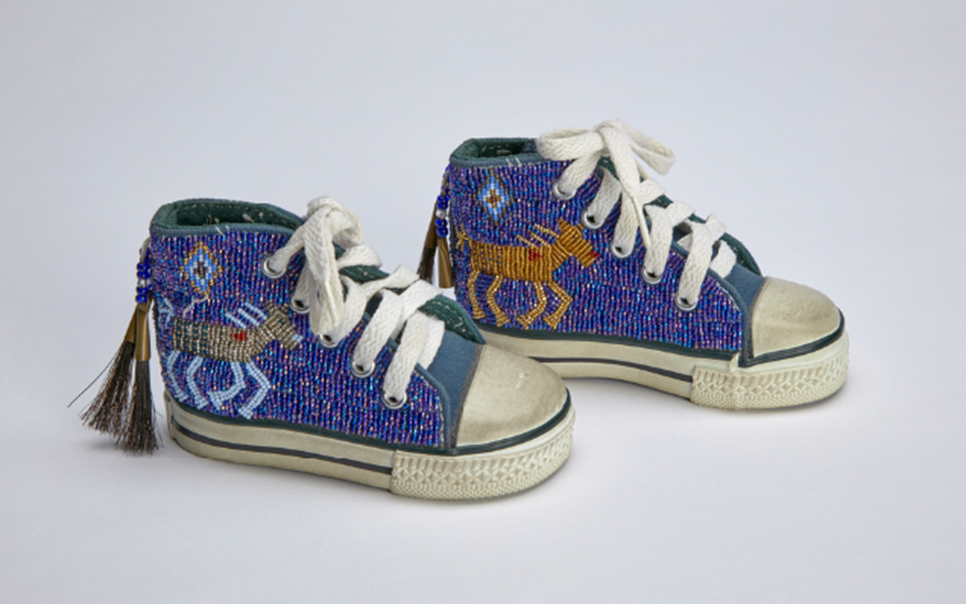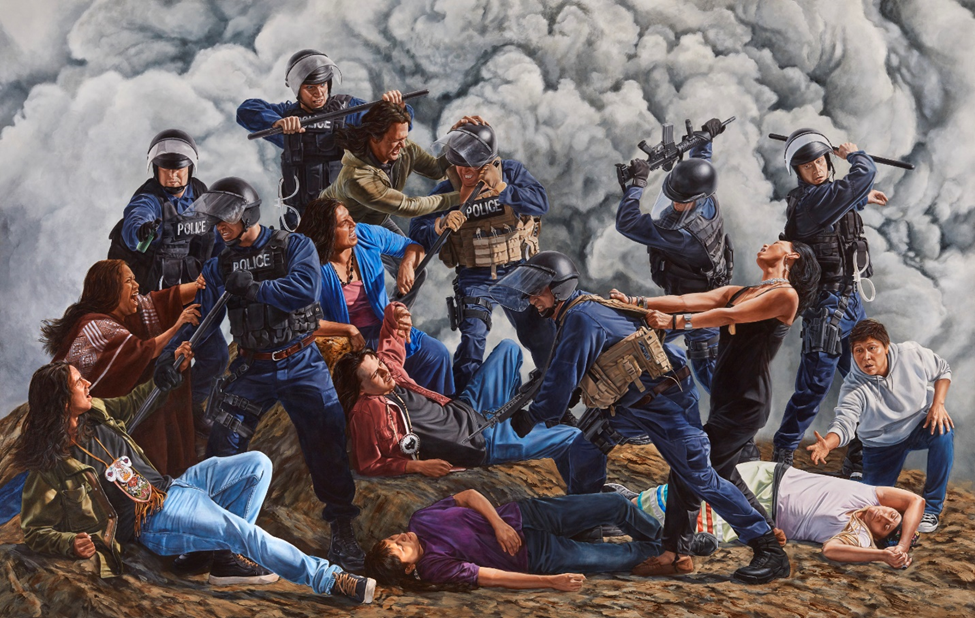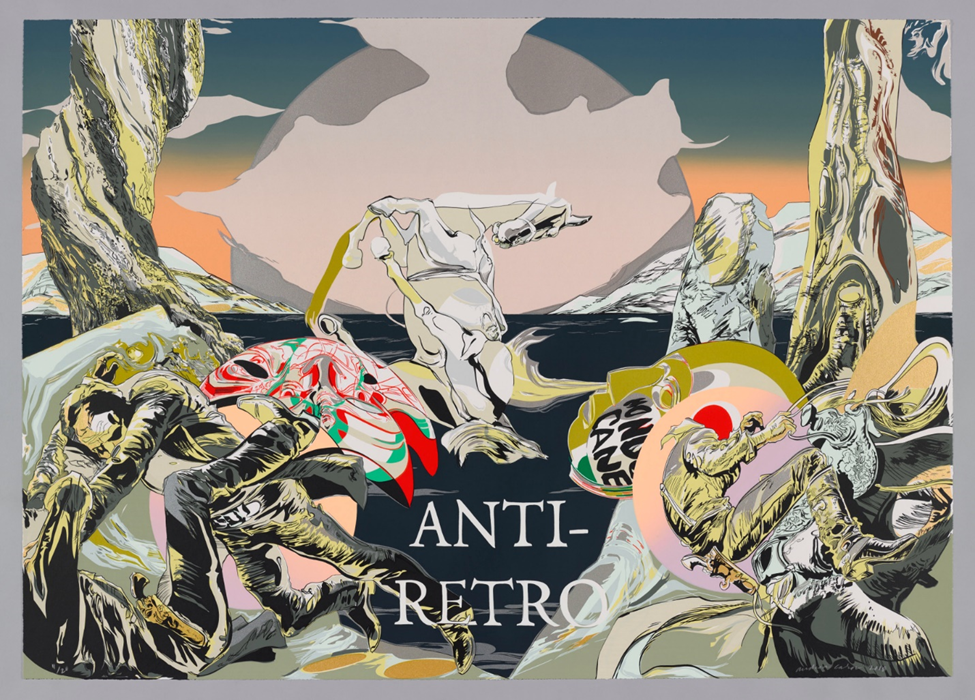
Courtesy of Tom Jones

Audio By Carbonatix
With more than 18,000 works and over 20,000 square feet of gallery space dedicated to the Indigenous Arts of North America, the Denver Art Museum’s collection of Native art is one of the largest in the world.
“One of the beauties of this collection is that not only were we collecting what was being made and supporting artists working at those times, we were also actively always at the vanguard of what was happening at major moments in Indigenous art history,” says John Lukavic, the DAM’s Andrew W. Mellon Curator of Native Arts.
“As an institution, we’ve been at the forefront of continuing to expand the field of Indigenous art, but it’s not really about us,” he adds. “It’s about the artists who’ve been doing the work. It’s about acknowledging the artists and the visual diversity of the works that are being created all across Native North America that really set the groundwork for the work that we’re doing today.”
According to Lukavic and associate curator Dakota Hoska, the museum’s commitment is based on collaboration and respect for Native voices. That mission will be on full display throughout 2025, when the DAM will commemorate its centennial of collecting Indigenous art with a series of dynamic exhibitions, including solo shows by renowned contemporary Indigenous artists Kent Monkman and Andrea Carlson.
Will you step up to support Westword this year?
At Westword, we’re small and scrappy — and we make the most of every dollar from our supporters. Right now, we’re $21,000 away from reaching our December 31 goal of $50,000. If you’ve ever learned something new, stayed informed, or felt more connected because of Westword, now’s the time to give back.
“One hundred years is a significant milestone for a Western institution. But as we discussed it, we realized that, while DAM has been around for 100 years, Native people have been here for eons,” Hoska says. “How do we reconcile those two histories? We decided to make it an opportunity to elevate Indigenous voices. We consulted with seven local advisers from various tribal communities to determine what would be meaningful to them, and we came up with a few ideas to honor the museum’s collection, which was built over the last century and centered on the people who created the work.”

Teri Greeves (Kiowa), Beaded Baby Converse with Horses, about 1997-99. Beads, cotton, and canvas; 5 1/2 in. x 3 1/2 in. x 2 1/2 in. each. Denver Art Museum: Funds from the Morgridge Family Foundation grant, 2023.
Courtesy of Teri Greeves
While most museums prioritized European art in 1925, the Denver Art Museum set itself apart by acknowledging the cultural and artistic significance of North American Indigenous communities. Frederic Huntington Douglas, the museum’s curator from 1929 to 1956, spearheaded its early efforts. Unlike other institutions, which frequently collected Indigenous art as artifacts or ethnographic objects, the DAM focused on contemporary work.
“We were celebrating the people living at those points in time, so we worked to develop relationships with the artists,” Lukavic explains. “Frederic was actively trying to create opportunities for Native people rather than simply glorifying or exoticizing historical arts.”
Lukavic, who has been with the museum for more than a decade, emphasizes the importance of cultural responsibility. Although he is not Native, he sees his role as one of stewardship. “I’ve worked with Native people my entire life, and I often say I’m walking on eggshells, but I don’t want it any other way,” Lukavic says. “I want to be held responsible for the work that I do. My goal is always to be as respectful as possible. Dakota and I share the view that our first audience is the Native communities coming to our galleries – we want to make sure that they’re seen, valued, heard and feel respected.”
A member of the Oglála LakÇŸóta Nation, enrolled in the Pine Ridge reservation from the Wounded Knee Community with the family name Little Moon, Hoska guides the museum’s efforts to center Indigenous voices through her lived experience.
“One of my goals is to dispel the myth that Indigenous people have an isolated experience,” Hoska says. “Native people do more than eat berries and gather nuts; we were always global, cosmopolitan people. What we are trying to do with the galleries today is show the ways that Indigenous artists were early adapters and innovators. I hope to continue that kind of work in the SUSTAINED! exhibition and further showcase the continuum of creativity within the Indigenous community.”

Kent Monkman (Fisher River Cree Nation), Victory for the Water Protectors, 2018. Acrylic paint on canvas, 84
Courtesy of Kent Monkman
For the centennial celebration, the DAM will unveil a major reinstallation of its Indigenous Arts of North America galleries in December. The exhibition SUSTAINED! The Persistent Genius of Indigenous Art was developed with input from seven local Indigenous advisers and delves into how beauty, spirituality and connections have sustained Native traditions over the past century; it will open on December 22 in the museum’s permanent gallery space and will be on display for two years.
“One of the advisers spoke eloquently about how, over the last century, Natives had been subjected to such terrible policies, and they were grateful that there was a place where they could be elevated, even during these extremely traumatic times,” Hoska says. “That became the underlying theme of the show. The show will combine historical and contemporary works but doesn’t follow a linear timeline. It’s not about that kind of progression; it’s about storytelling and how things were sustained.”
Among the key pieces are “Earrings for the Gods,” by Eric Paul Riege (Diné); a striking breastplate crafted from gun shell casings by Sid Whiting (SiÄháŋǧu LakÇŸóta); a dress by fashion designer Orlando Dugi (Diné); and a newly commissioned work by Teri Greeves (Kiowa).
Up next will be Kent Monkman’s show, History Is Painted by the Victors, which opens on April 20, 2025. Monkman, a Cree artist, is known for his large-scale paintings that question traditional Western historical narratives and often incorporate his alter ego, Miss Chief Eagle Testickle, into iconic scenes. His work addresses the erasure of Indigenous voices in art history while championing LGBTQ+ and Indigenous identities, including Two Spirit.
Monkman’s show at the DAM has been in development since 2018 and will include 41 monumental paintings, many of which are larger than life. Some of the works on display are as wide as 24 feet, creating immersive, provocative visual experiences. This will be Monkman’s first large-scale exhibition in the United States; it was organized in collaboration with the Montreal Museum of Fine Arts, where it will tour after its debut in Denver.
“His work has a sense of camp and humor in it, which helps to diffuse a difficult situation and allows the viewer to spend time with it and understand what he is doing,” Lukavic says. “His work consistently addresses very strong and powerful messages, such as land reclamation and centering longstanding identities and realities. The exhibition delves into some heavy subject matter. The reality is that some of the subject matter may offend some people, but it can also make another person feel seen and validated because their life experiences are often acknowledged for the first time in public.”

Andrea Carlson (Ojibwe, born 1979), Anti-Retro, 2018. 19-layer screenprint on paper. Denver Art Museum: Native Arts acquisition funds, 2020.
Courtesy of Andrea Carlson and Bockley Gallery
Following Monkman’s exhibition, the DAM will turn its attention to Andrea Carlson, a mixed-media artist of Ojibwe descent whose work blends Indigenous Futurism with themes of resistance, sovereignty and cultural survival. Carlson’s first major museum survey, opening in October 2025, will display forty of her intricate works on paper and sculptures, including a newly commissioned monumental piece. Known for her scrupulous layering of iconography, Carlson challenges viewers to rethink conventional depictions of Indigenous lands and histories.
“Carlson’s meticulous, multi-layered practice continues to be a source of inspiration for many, and I’m delighted that DAM is providing this important platform to share her work with national and international audiences,” Hoska says. “By taking objects from museum settings and placing them in her own landscapes, Carlson reverses the idea of ‘ownership’ and deconstructs what it means to be interpreted as a stereotype.”
In addition to the major exhibitions by Monkman and Carlson, the museum has planned several events throughout 2025 for the centennial. One of the most anticipated is a two-day symposium scheduled for next November that will bring together Indigenous scholars, artists and community members to discuss the future of Indigenous art in museum spaces.
The DAM will also continue its Native Arts Artist-in-Residence program, which selects two new artists to live and work in Denver for three weeks. Indomitably Indigenous, an annual showcase of Indigenous youth art, will take place from this November to January 2025, highlighting emerging talent in the Denver area. As the museum marks a century of championing Indigenous art, it is also looking ahead.
“For so long, DAM was among the only institutions that really focused on Indigenous arts; now it’s all the rage,” Lukavic says. “Museums all across the country are creating new positions; they’re doing exhibitions; they’re integrating Indigenous arts into the American art context; they’re doing all sorts of things. We’ve been thinking about what we can continue to do to help the field. Going global by touring our collection is one of the areas that we see as more of an opportunity for Indigenous arts [where] we can use our resources and our platform to help reach more people.”
Learn more about the DAM’s Indigenous Arts of North America collection and its 100-year events at denverartmuseum.org.